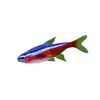The Cardinal tetra is the most well-known and charming aquarium fish among the freshwater pet fish keepers due to its toughness and magnificent body coloration which is also called the Red Neon Tetra. It is an Actinopterygian ray-finned fish under Characidae family of order Characiformes. This Characin (Paracheirodon axelrodi) was first exposed by Schultz (A Famous American Ichthyologist) in 1956. It is not recorded as threatened species on the IUCN Red Data List. Synonyms of this species are Cheirodon axelrodi, Hyphessobrycon cardinalis.
Systematic Position
- Phylum: Chordata
- Subphylum: Vertebrata
- Class: Actinopterygii
- Order: Characiformes
- Family: Characidae
- Genus: Paracheirodon
- Species:Paracheirodon axelrodi
Distribution and Habitat
This fish is distributed in Brazil, Northern South America, Eastern Colombia, and Venezuela. They are additionally found in the Orinoco River and the tributaries of the Rio Negro. It happens in overflowed woods regions, especially little, shallow rivulets and moderate flowing streams. They prefer to live in shores, predominantly in the column layers of water where lots of food and thick vegetation with good water are available.
Quick Cardinal Tetra Facts
- Scientific Name:Paracheirodon axelrodi
- Common Name: Red neon tetra
- Origin: Brazil, Colombia, and Venezuela
- Maximum Size: 5.08 cm (2.0 inches)
- Temperament: Peaceful
- Tank Level: All
- Minimum Tank Size: 20 gallons
- Diet: Omnivore
- Breeding: Egg-layer
- pH: 5.5-7.5
- Hardness: 4-8 dGH
- Temperature: 73.0 to 81.0° F (22.8 to 27.2° C)
- Water Movement: Moderate
- Lighting need: Low – medium lighting
- Care level: Moderate
- Lifespan: 5 years
Body Shape and Colors
The Cardinal Tetra is wonderful and appealing fish among the pet fish keepers. It has extended and horizontal compacted body with a blunt nose. The upper side of the body is tanish red in color while the ventral part is splendid red in color. A wide single blue stripe is available that reaches out along each side of the fish from the upper parts of the eye to simply beneath the adipose fin. All fins are simple, transparent and without any spines.

Size and Lifespan
Generally, the female body is larger than the male of the same age. The female grows up to 5.08 cm long (2 inches) while the male can grow up to 3.0 cm (1.25 inches). They can live up to 5 years or more if you take proper care.
Food and Feeding Behavior
They take both plants and meaty foods. In nature, normal food comprises of crustaceans, fish eggs, algae, debris and different sorts of worms. In hostage condition, live food such as brine shrimp, Tubifex, mosquito larvae, Chironomous larvae, Cyclops and Daphnia etc should be provided to make them happier. You should offer food 2 or 3 times each day with a small amount to avoid food waste.
Housing and Care Facts
The cardinal tetra is excellent aquarium fish and it requires no less than 20 gallons tank but a larger tank is suggested. They prefer good water parameters (pH: 5.5 to 7.5; water hardness: 4 to 8 dGH) with plenty of swimming place. To make your tank environment natural, you should add some driftwood, aquatic plants and dark substrates to the tank.
The suitable temperature for the fish is 73.0 – 81.0° F (22.8 to 27.2° C). This fish is an active jumper and the tank needs a suitable cover or lid to prevent jumping out. To make your aquarium healthy, changes of water is fundamental. At least 25% of the water should be changed each week, particularly if you keep much fish in the tank.
Tank-mates
The Cardinal Tetra is a community fish and you can keep it in groups of at least six individuals with peaceful tank-mates. Suitable tank-mates include Rasboras, Cichlids, Anabantoids and small Loricariids.
Breeding Behavior
In hostage condition, they can easily breed if you take appropriate care. For spawning effectively in aquarium condition, brood fish should be adapted to protein-rich food, for example, flake food with some meaty foods like Daphnia, Cyclops, and Bloodworms. For successful breeding, water parameters play a great role. In this case, the breeding tank should have a temperature between 75- 82° F with a pH of 5.5 – 6.0 and normal to subdued illumination should be provided.
At suitable breeding condition, the female lays about 500 eggs. Hatching of eggs occurs within 24 hours. At this time parents should be removed from the breeding tank as they eat eggs and fry. Within 3-4 days after hatching, the baby fish become free swimming. For proper growth, the baby fish ought to be fed newly hatched artemia, micro-worm, and infusoria. You can also feed them with any liquid fry food.
Male and Female Sex Differences
Differentiation of male and female fish is very hard. The male is thin but females are marginally bigger and more extensive. During the spawning season, the female body becomes rounded and somewhat bigger than guys. At this time, the male bears rigid hooks in pelvic fin.
Disease and Preventive Measures
The Cardinal Tetra is a hardy fish but it can susceptible to skin flukes, parasitic infestations (Protozoans, Crustaceans, Helminths, and Nematodes), bacterial and fungal infections due to improper tank management. To make your fish disease free and healthy, provide natural tank environment and well-balanced diet.
Proper quarantine should be taken before adding new fish, substrates and any decorations to the tank. Suitable water quality parameters should be maintained in the tank water. In this case, partial water changes should be done on a regular basis.
Also read: Aquarium Fish Profile: Jaguar Cichlid
Final Thoughts
Overall, the cardinal tetra is incredibly excellent and well-known fish among the freshwater aquarium fish managers. It looks like to neon tetra (Paracheirodon innesi) and available in pet fish store or online shops with sensible cost. To keep your aquarium more appealing, we prescribe you to purchase this good-looking fish for your aquarium.
